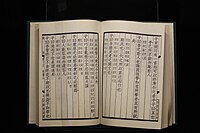The Analects
Welcome to the Wikibook of The Analects of Confucius.

Objectives
editThis book is to help students gain a deeper understanding of Chinese writing, philosophy and thinking through exposure to the sayings and dialogues of Confucius. The Analects was one of the compulsory texts for Chinese students studying for the imperial examinations of ancient China. A student's ability to write Chinese essays can be rapidly improved through such exposure.
Structure of the Wikibook
editThe Analects is presented in two forms, namely, simplified Chinese and Chinese pinyin (transliteration). The original text was written in traditional Chinese, but is now rendered in simplified Chinese, as it is widely used today. The Chinese pinyin form helps in the pronunciation and understanding of the text. The original text did not include pinyin, and since Chinese is not a phonetic language (i.e. not based on an alphabet), there is no guide to pronunciation in the source text. (Incidentally, there is also no punctuation in the original text.) Even simple words can have various pronunciations, as well as different associated meanings. For example, the word 乐 can be read as yuè (which means "music") or lè (which means "happiness")[1]. As many Chinese words sound alike, but are written differently with different meanings, homophones are used to evoke imagery or meanings that cannot be easily accessed otherwise.
Prerequisites
editKnowledge of some basic Chinese characters before starting this course is preferred. If you do not have some knowledge of basic Chinese, an online or offline dictionary will be helpful.
On the other hand, this book can help those who can speak but not write Chinese. The pinyin form is spoken Chinese, rendered in an accessible phonetic form. The pinyin form can therefore help one to learn how to read and write Chinese, if one is already familiar with the spoken word.
Introduction
edit《论语》是孔子及其弟子言论的汇编,由孔子门生及再传弟子集录整理;是儒家的重要经典,是研究孔子及儒家思想尤其是原始儒家思想的主要资料。南宋时朱熹将《论语》、《孟子》、《大学》、《中庸》合为“四书”,使之在儒家经典中的地位日益提高。今本《论语》共计20篇,1.2万字。
The Analects (traditional Chinese: 論語; simplified Chinese: 论语; pinyin: Lún Yǔ), also known as the Analects of Confucius, are a record of the words and acts of the central Chinese thinker and philosopher Confucius and his disciples, as well as the discussions they held.
Contents
edit- /序說|序說
- tacingga ujui fiyelen (學而第一)
- 为政第二 (為政第二)
- /八佾第三|八佾第三
- /里仁第四|里仁第四
- /公冶長第五|公冶長第五
- /雍也第六|雍也第六
- /述而第七|述而第七
- /泰伯第八|泰伯第八
- /子罕第九|子罕第九
- /鄉黨第十|鄉黨第十
- /先進第十一|先進第十一
- /顏淵第十二|顏淵第十二
- /子路第十三|子路第十三
- /憲問第十四|憲問第十四
External Links & References
edit- https://librivox.org/lun-yu-or-analects-of-confucius-read-in-chinese/ (Audio archive in mp3 format)
- Analects on Wikisource
Read more
editNotes
edit